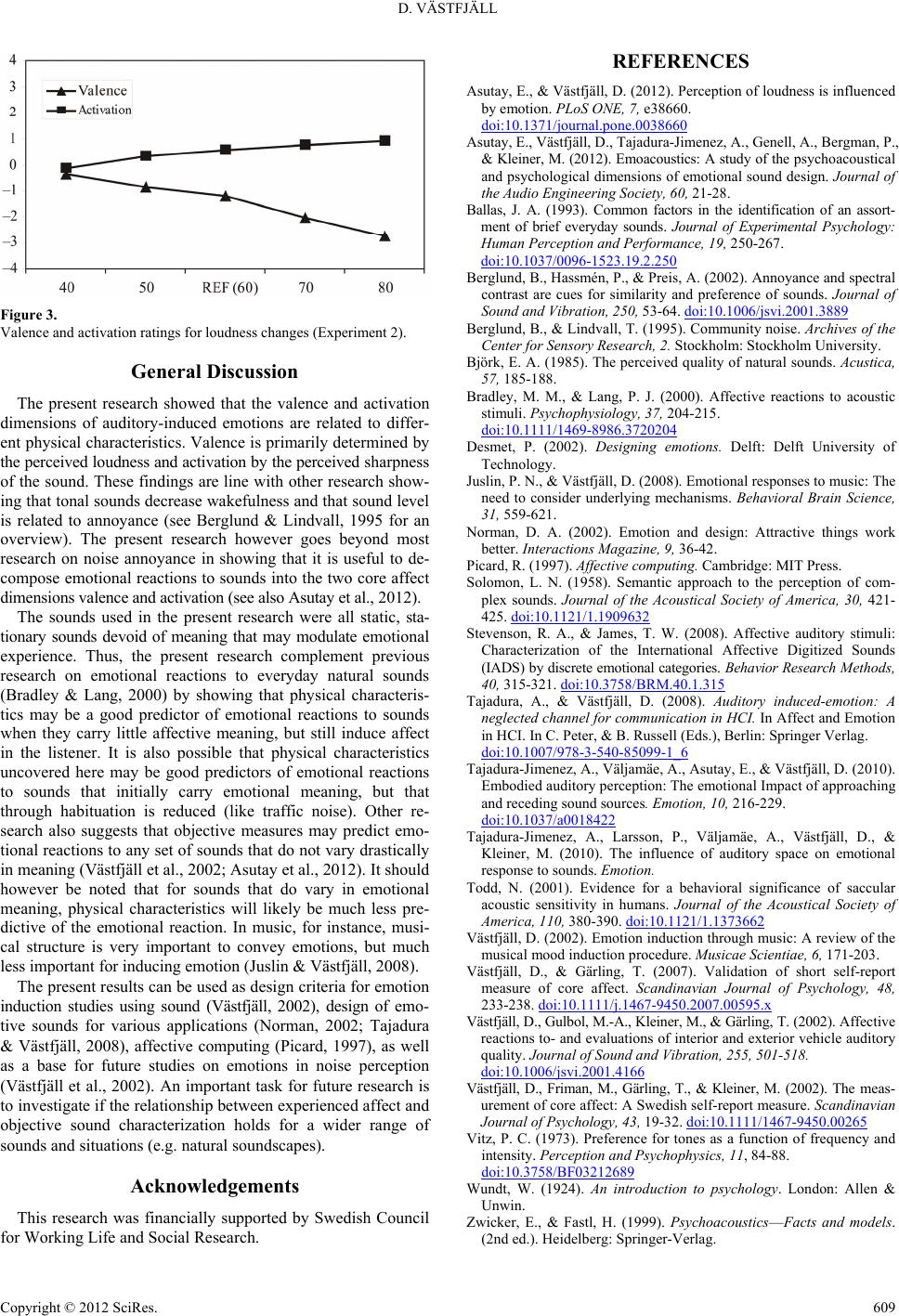
D. VÄSTFJÄLL
Copyright © 2012 SciRes. 609
REFERENCES
Asutay, E., & Västfjäll, D. (2012). Perception of loudness is influenced
by emotion. PLoS ONE, 7, e38660.
doi:10.1371/journal.pone.0038660
Asutay, E., Västfjäll, D., Tajadura-Jimenez, A., Genell, A., Bergman, P.,
& Kleiner, M. (2012). Emoacoustics: A study of the psychoacoustical
and psychological dimensions of emotional sound design. Journal of
the Audio Engineering Society, 60 , 21-28.
Ballas, J. A. (1993). Common factors in the identification of an assort-
ment of brief everyday sounds. Journal of Experimental Psychology:
Human Perception and Performance, 19, 250-267.
doi:10.1037/0096-1523.19.2.250
Berglund, B., Hassmén, P., & Preis, A. (2002). Annoyance and spectral
contrast are cues for similarity and preference of sounds. Journal of
Sound and Vibratio n, 250, 53-64. doi:10.1006/jsvi.2001.3889
Figure 3. Berglund, B., & Lindvall, T. (1995). Community noise. Archives of the
Center for Sensory Res ea rc h, 2. Stockholm: Stockholm University.
Valence and activation ratings for loudness changes (Experiment 2).
Björk, E. A. (1985). The perceived quality of natural sounds. Acustica,
57, 185-188.
General Discussion
Bradley, M. M., & Lang, P. J. (2000). Affective reactions to acoustic
stimuli. Psychophysiology, 37, 204-215.
doi:10.1111/1469-8986.3720204
The present research showed that the valence and activation
dimensions of auditory-induced emotions are related to differ-
ent physical characteristics. Valence is primarily determined by
the perceived loudness and activation by the perceived sharpness
of the sound. These findings are line with other research show-
ing that tonal sounds decrease wakefulness and that sound level
is related to annoyance (see Berglund & Lindvall, 1995 for an
overview). The present research however goes beyond most
research on noise annoyance in showing that it is useful to de-
compose emotional reactions to sounds into the two core affect
dimensions valence and activation (see also Asutay et al., 2012).
Desmet, P. (2002). Designing emotions. Delft: Delft University of
Technology.
Juslin, P. N., & Västfjäll, D. (2008). Emotional responses to music: The
need to consider underlying mechanisms. Behavioral Brain Science,
31, 559-621.
Norman, D. A. (2002). Emotion and design: Attractive things work
better. Interactions Magazine, 9, 36-42.
Picard, R. (1997). Affecti ve computing. Cambridge: MIT Press.
Solomon, L. N. (1958). Semantic approach to the perception of com-
plex sounds. Journal of the Acoustical Society of America, 30, 421-
425. doi:10.1121/1.1909632
The sounds used in the present research were all static, sta-
tionary sounds devoid of meaning that may modulate emotional
experience. Thus, the present research complement previous
research on emotional reactions to everyday natural sounds
(Bradley & Lang, 2000) by showing that physical characteris-
tics may be a good predictor of emotional reactions to sounds
when they carry little affective meaning, but still induce affect
in the listener. It is also possible that physical characteristics
uncovered here may be good predictors of emotional reactions
to sounds that initially carry emotional meaning, but that
through habituation is reduced (like traffic noise). Other re-
search also suggests that objective measures may predict emo-
tional reactions to any set of sounds that do not vary drastically
in meaning (Västfjäll et al., 2002; Asutay et al., 2012). It should
however be noted that for sounds that do vary in emotional
meaning, physical characteristics will likely be much less pre-
dictive of the emotional reaction. In music, for instance, musi-
cal structure is very important to convey emotions, but much
less important for inducing emotion (Juslin & Västfjäll, 2008).
Stevenson, R. A., & James, T. W. (2008). Affective auditory stimuli:
Characterization of the International Affective Digitized Sounds
(IADS) by discrete emotional categories. Behavior Research Methods,
40, 315-321. doi:10.3758/BRM.40.1.315
Tajadura, A., & Västfjäll, D. (2008). Auditory induced-emotion: A
neglected channel for communication in HCI. In Affect and Emotion
in HCI. In C. Peter, & B. Russell (Eds.), Berlin: Springer Verlag.
doi:10.1007/978-3-540-85099-1_6
Tajadura-Jimenez, A., Väljamäe, A., Asutay, E., & Västfjäll, D. (2010).
Embodied auditory perception: The emotional Impact of approaching
and receding sound sources. Emotion, 10, 216-229.
doi:10.1037/a0018422
Tajadura-Jimenez, A., Larsson, P., Väljamäe, A., Västfjäll, D., &
Kleiner, M. (2010). The influence of auditory space on emotional
response to sounds. E motion.
Todd, N. (2001). Evidence for a behavioral significance of saccular
acoustic sensitivity in humans. Journal of the Acoustical Society of
America, 110, 380-390. doi:10.1121/1.1373662
Västfjäll, D. (2002). Emotion induction through music: A review of the
musical mood induction procedure. Musicae Scientiae, 6, 171-203.
Västfjäll, D., & Gärling, T. (2007). Validation of short self-report
measure of core affect. Scandinavian Journal of Psychology, 48,
233-238. doi:10.1111/j.1467-9450.2007.00595.x
The present results can be used as design criteria for emotion
induction studies using sound (Västfjäll, 2002), design of emo-
tive sounds for various applications (Norman, 2002; Tajadura
& Västfjäll, 2008), affective computing (Picard, 1997), as well
as a base for future studies on emotions in noise perception
(Västfjäll et al., 2002). An important task for future research is
to investigate if the relationship between experienced affect and
objective sound characterization holds for a wider range of
sounds and situations (e.g. natural soundscapes).
Västfjäll, D., Gulbol, M.-A., Kleiner, M., & Gärling, T. (2002). Affective
reactions to- and evaluations of interior and exterior vehicle auditory
quality. Journal of Sound and Vibration , 255, 501-518.
doi:10.1006/jsvi.2001.4166
Västfjäll, D., Friman, M., Gärling, T., & Kleiner, M. (2002). The meas-
urement of core affect: A Swedish self-report measure. Scandinavian
Journal of Psychology, 43, 19-32. doi:10.1111/1467-9450.00265
Vitz, P. C. (1973). Preference for tones as a function of frequency and
intensity. Perception and Psychophysics, 11, 84-88.
doi:10.3758/BF03212689
Acknowledgements Wundt, W. (1924). An introduction to psychology. London: Allen &
Unwin.
This research was financially supported by Swedish Council
or Working Life and Social Research. Zwicker, E., & Fastl, H. (1999). Psychoacoustics—Facts and models.
(2nd ed.). Heidelberg: Springer-Verlag.
f